11/15/2020. Remarks by Johan Visschedijk: "Naval interest in new equipment ultimately to replace the Barracuda became evident with the issue of Specification O.5/43 of December 23, 1943, for a two-seat torpedo dive-bomber able to undertake also antisubmarine patrols and scouting. Any suitable British engine could be used, and maximum measurements were to be span 60 ft (18.30 m) extended and 20 ft (6.10 m) folded, length 45 ft. 6 in (13.87 m) and height 17 ft (5.18 m).
To comply with O.5/43 chief designer Herbert Eugene Chaplin devised a new Fairey monoplane. The Spearfish was one of the handsomest of torpedo-bombers, with an imposing appearance and wings of 60 ft 3 in (18.36 m) span set at mid-depth in the fuselage. The pilot, armed with two 0.50 in (12.7 mm) Brownings mounted one in each wing, was seated in an ideal position in line with the leading edge. The observer, responsible also for the operation of the radar equipment, was located a few feet aft under the canopy, from which point he fired the pair of 0.50 in (12.7 mm) Brownings housed in a low-set Frazer F.N.95 power-driven dorsal barbette immediately to his rear. (So far as is known the barbette aft of the cockpit was never installed, although it had been flight-tested in a Grumman Avenger.)
Outboard of the straight center section, dihedral was incorporated in the tapered outer wing panels which accommodated also the retracted main landing gear legs. Six prominent guides along the wings' trailing edge enabled the Fairey-Youngman high-lift flaps to be lowered, and dive-brakes formed part of both upper and lower wing surfaces. The wings folded to the rear to lie upright along the sides of the fuselage, and a deck arrester hook was embodied in the extreme tail. The Spearfish's capacious bomb-bay extended from the fire-wall to a point midway between the wings and the tail and was able to house alternative offensive loads consisting of one 18 in (45.7 cm) or one 22.4 in (56.9 cm) torpedo, four 500 lb (227 kg) bombs, one 1,600 lb (726 kg) bomb or four depth charges. When operating as a dive-bomber an ejector installed in the bomb-bay was arranged to swing the bomb clear of the aircraft.
Before the power plant to be employed was settled, several alternative layouts were considered, among them a normal twin-engine design, the use of a piston engine in the nose together with a gas turbine at the rear, and conventionally-mounted single Bristol Centaurus, Rolls-Royce Exe or Napier Sabre units. Eventually, the first prototype (pictured above) received the 2,585 hp Centaurus 57 eighteen-cylinder two-row radial, driving a five-blade Rotol constant-speed propeller. The Spearfish's rear fuselage housed a retractable Mk.15 air-to-surface-vessel (ASV) radar scanner, and sixteen Mk.VIII zero-length rocket mountings were installed beneath the wings.
With Chief Test Pilot Foster H. 'Dickie' Dixon at the controls, the first Spearfish prototype (serialed RA356) made its maiden flight on July 5, 1945. Four additional prototypes were completed with a 2,800 hp Centaurus 58s as power plant. Three were flown, RN241 (December 29, 1945), RA360 (April 11, 1947), and RA363 (September 23, 1947). In the event, the fourth, RN244, was not flown, although three more Spearfish prototypes had been ordered under the serials TJ175, TJ194 and TJ184, however, only TJ175 was assembled, but not completed. Forty production Spearfish TBD Mk.1s were ordered to be produced by the Fairey factory at Stockport. However, despite the type's ability to fulfil a greater variety of roles than any previous Fleet Air Arm carrier-borne design, the contract was cancelled."
